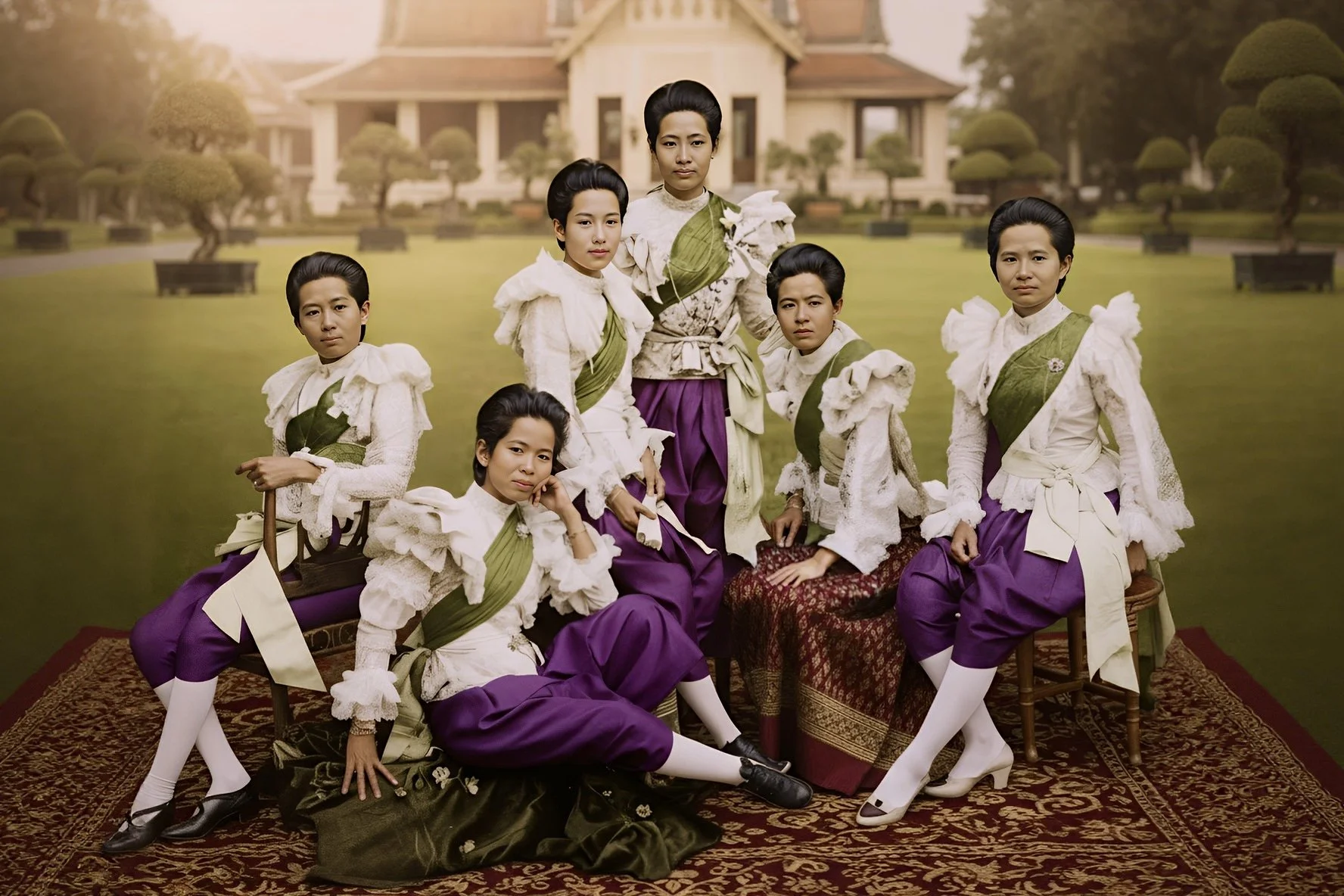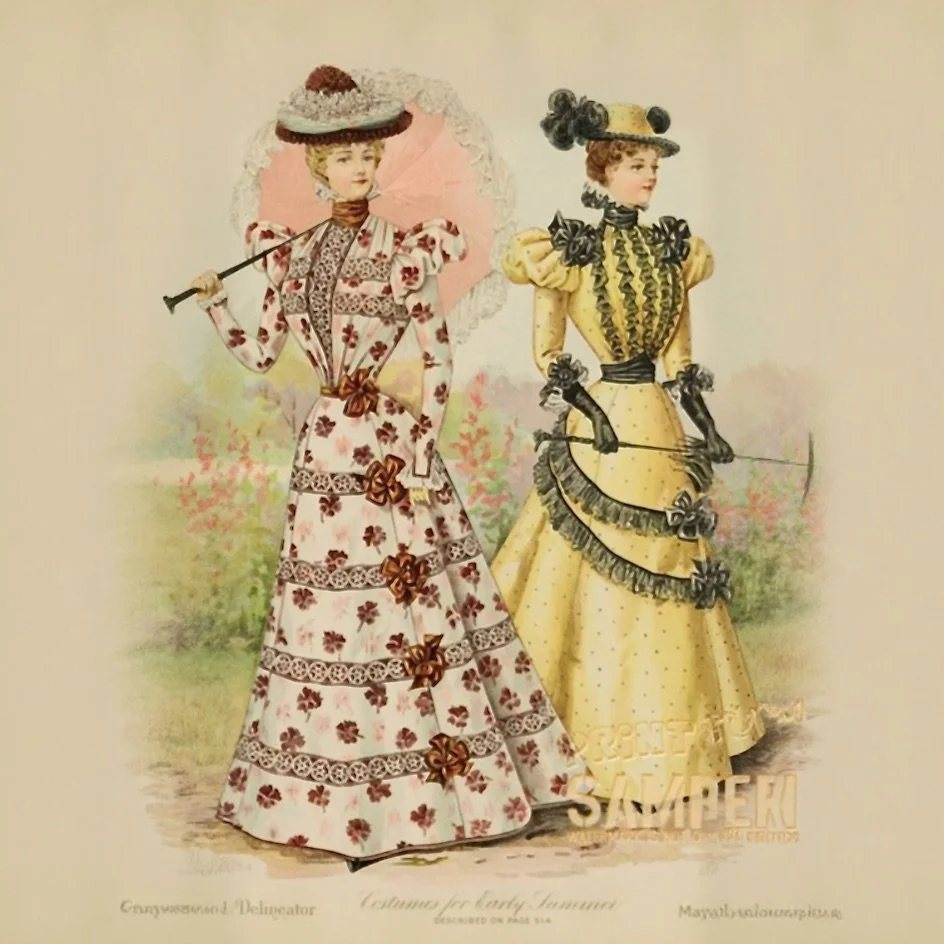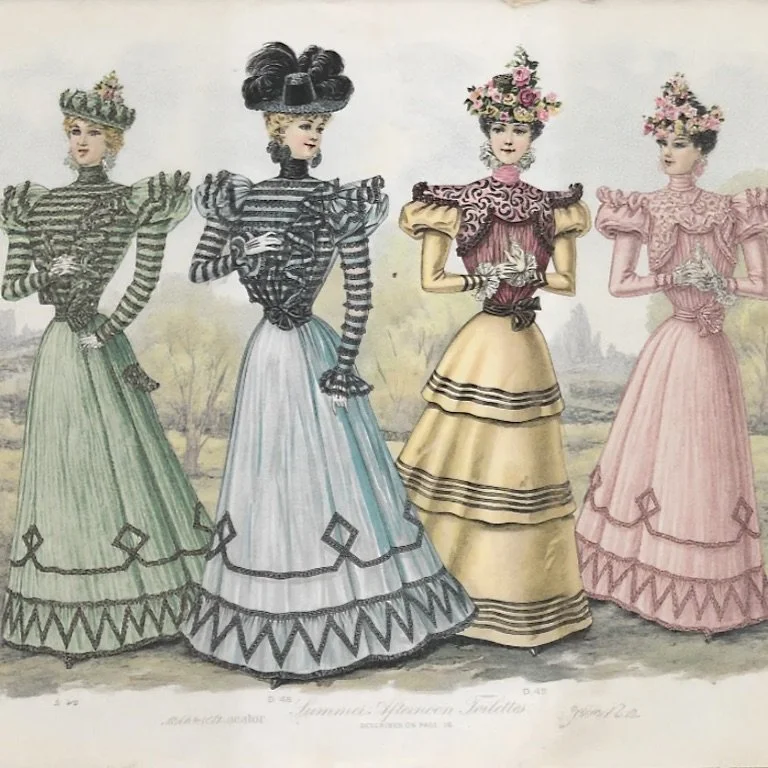แขนเสื้อแบบระบายซ้อนชั้น (Manches à volants superposés / Tiered Flounce Sleeves) ค.ศ. 1897 (พ.ศ. 2440)
แขนเสื้อแบบระบายซ้อนชั้น (Manches à volants superposés / Tiered Flounce Sleeves) ค.ศ. 1897 (พ.ศ. 2440) และการเข้ามาในราชสำนักสยาม (ตอนที่ 2)
พระรูปที่ได้รับการบูรณะและสร้างสรรค์ด้วยเทคโนโลยี AI นี้ สร้างสรรค์ด้วย หลักคู่สีประจำวันแบบสวัสดิรักษา วันเสาร์ คือ “นุ่งเม็ดมะปราง ห่มโศก” (นุ่งผ้าสีม่วง ห่มผ้าสีเขียวอ่อน)
ต้นกำเนิดในปารีส: การเปลี่ยนผ่านจากแฟชั่นแขนเสื้อทรงแขนหมูแฮม
ในช่วงกลางคริสต์ศตวรรษที่ 19 ปลายทศวรรษ 1890 แฟชั่นสตรีในยุโรปถึงจุดสูงสุดของ แขนเสื้อทรงแขนหมูแฮม (Leg-of-Mutton Sleeve / Gigot Sleeve) ซึ่งขยายใหญ่เป็นพิเศษในราว ค.ศ. 1895–1896 (พ.ศ. 2438–2439) แต่เมื่อถึง ฤดูใบไม้ร่วง ค.ศ. 1897 (พ.ศ. 2440) รูปทรงดังกล่าวเริ่มลดขนาดลง ดีไซเนอร์ในปารีสจึงนำเสนอความละเอียดอ่อนแบบใหม่ คือ การออกแบบ แขนเสื้อแบบระบายซ้อนชั้น (Manches à volants superposés / Tiered Flounce Sleeves) โดยการนำลูกไม้หรือผ้าซ้อนเป็นชั้น ๆ เป็นระบาย แล้วไล่ระดับลงมาตามหัวไหล่และต้นแขน
สไตล์ใหม่นี้ปรากฏในนิตยสารแฟชั่นฝรั่งเศส เช่น La Mode Illustrée (ค.ศ. 1897 / พ.ศ. 2440) ซึ่งชี้ว่าเป็นการเปลี่ยนผ่านจากความอลังการของแขนเสื้อทรงแขนหมูแฮมไปสู่ความอ่อนหวานโรแมนติก อันจะปูทางสู่แฟชั่นยุคเอ็ดเวิร์ด (Edwardian Fashion) ในต้นคริสต์ศตวรรษที่ 20 หรือช่วงรัชกาลที่ ๕ ตอนปลาย
การเผยแพร่เข้าสู่ราชสำนักสยาม
ในปีเดียวกันนั้น พระบาทสมเด็จพระจุลจอมเกล้าเจ้าอยู่หัว (King Chulalongkorn, Rama V, 1853–1910 / พ.ศ. 2396–2453) เสด็จฯ ประพาสยุโรปครั้งที่ ๑ ใน ค.ศ. 1897 (พ.ศ. 2440) ซึ่งตรงกับช่วงเวลาที่แขนเสื้อแฟชั่นแบบใหม่กำลังเผยโฉมที่ปารีส สันนิษฐานได้ว่าพระองค์อาจทรงจัดหาชุดแฟชั่นหรือตัดเย็บเสื้อผ้าล่าสุดจากฝรั่งเศสเพื่อพระราชทานแก่เจ้านายฝ่ายในและพระราชธิดาในราชสำนัก
การนำแฟชั่นใหม่นี้เข้าสู่ราชสำนักไทยจึงมิใช่เพียงการติดตามสมัยนิยม หากแต่เป็น สัญลักษณ์แห่งความเป็นสมัยใหม่ (Modernity) และการเชื่อมโยงกับราชสำนักยุโรป การสวมใส่เสื้อผ้าลูกไม้วิคตอเรียทรงแขนเสื้อแบบระบายซ้อนชั้น จึงกลายเป็นการแสดงสถานะและพระบารมีของพระราชสำนักสยาม และฝ่ายใน ในสายตานานาชาติ
ตัวอย่างเจ้านายฝ่ายใน ในราชสำนักสยาม ที่ทรงฉลองพระองค์ผ้าลูกไม้ในแบบแฟชั่นวิคตอเรียตอนปลายด้วยแขนเสื้อแบบระบายซ้อนชั้น พระรูปนี้ คาดว่าฉายในปี พ.ศ. ๒๔๔๐ (ค.ศ. 1897) หรือหลังจากนั้น
เราสามารถอ่านภาพได้จากการคำนวนอายุของ กรมหลวงศรีรัตนโกสินทร พระองค์ประสูต พ.ศ. ๒๔๒๐ ในพระรูปนี้พระองค์มีพระชันษา ประมาณ ๒๐ ปี และประวัติศาสตร์แฟชั่นของการสร้างสรรค์แขนเสื้อแบบระบายซ้อนชั้น ซึ่งสร้างสรรค์ขึ้นมาและเป็นที่นิยมในปารีส ในปี พ.ศ. ๒๔๔๐ ช่วยให้เราให้สามารถกำหนดอายุของพระรูปนี้ได้อย่างไรแม่นยำ
เจ้านายฝ่ายในรัชสมัยรัชกาลที่ ๕ (จากซ้าย): พระเจ้าบรมวงศ์เธอ พระองค์เจ้านภาพรประภา กรมหลวงทิพยรัตนกิริฎกุลินี, พระเจ้าบรมวงศ์เธอ พระองค์เจ้าประดิษฐาสารี, สมเด็จพระเจ้าบรมวงศ์เธอ เจ้าฟ้าสุทธาทิพยรัตน์ กรมหลวงรัตนโกสินทร, พระเจ้าบรมวงศ์เธอ พระองค์เจ้าบุษบันบัวผัน, พระเจ้าบรมวงศ์เธอ พระองค์เจ้าพวงสร้อยสอางค์ และสมเด็จพระปิตุจฉาเจ้าสุขุมาลมารศรี พระอัครราชเทวี
พระเจ้าบรมวงศ์เธอ พระองค์เจ้าพวงสร้อยสอางค์ (Princess Puangsoi Sa-ang, 1866–1950 / พ.ศ. 2409–2493)
พระราชธิดาในพระบาทสมเด็จพระจอมเกล้าเจ้าอยู่หัว (King Mongkut, Rama IV, 1804–1868 / พ.ศ. 2347–2411) ประสูติแต่เจ้าจอมมารดาเที่ยง (Chao Chom Manda Tieng Rojanadis) และเป็นพระเชษฐภคินีร่วมบิดาของพระบาทสมเด็จพระจุลจอมเกล้าเจ้าอยู่หัว ทรงฉลองพระองค์ลูกไม้พร้อม แขนเสื้อซ้อนชั้นระบาย (Manches à volants superposés / Tiered Flounce Sleeves)ตกแต่งด้วยริบบิ้นสีพาสเทล แสดงถึงการที่เจ้านายฝ่ายในระดับสูงรับอิทธิพลแฟชั่นปารีสอย่างรวดเร็วสมเด็จพระเจ้าบรมวงศ์เธอ เจ้าฟ้าสุทธาทิพยรัตน์ กรมหลวงศรีรัตนโกสินทร (Princess Suddha Dibyaratana, 1877–1922 / พ.ศ. 2420–2465)
พระราชธิดาในพระบาทสมเด็จพระจุลจอมเกล้าเจ้าอยู่หัว กับสมเด็จพระปิตุจฉาเจ้า สุขุมาลมารศรี พระอัครราชเทวี (Queen Sukhumala Marasri, 1861–1927 / พ.ศ. 2404–2470) เจ้าฟ้าสุทธาทิพยรัตน์ทรงฉลองพระองค์ที่ปรากฏมี แขนเสื้อลูกไม้ซ้อนชั้น คาดแพรสะพายแพร แสดงถึงการผสมผสานแฟชั่นปารีสกับสัญลักษณ์ชั้นสูงของสยามเจ้าจอมมารดาชุ่ม ไกรฤกษ์ (Chao Chom Manda Chum Krairoek, 1869–1911 / พ.ศ. 2412–2454) ธิดาของพระมงคลรัตนราชมนตรี (Phraya Mongkolrat Rajamontri, ช่วง ไกรฤกษ์) สวมชุดลูกไม้พร้อม ชั้นระบายพริ้วบนหัวไหล่ ตอกย้ำภาพลักษณ์แห่งความสง่างาม และเป็นการสะท้อนว่าไม่เพียงแต่เจ้าฟ้า แต่แม้แต่เจ้าจอมก็ต่างมีโอกาสได้สวมใส่แฟชั่นใหม่เช่นกัน
เจ้าจอมมารดาโหมด บุนนาค (Chao Chom Manda Mod Bunnag, 1863–1932 / พ.ศ. 2406–2475) ธิดาของเจ้าพระยาสุรวงษ์ไวยวัฒน์ (Chao Phraya Surawongwaiwat, Worn Bunnag, 1829–1882 / พ.ศ. 2372–2425) สวมเสื้อแบบ แขนเสื้อแบบซ้อนชั้น ประกอบกับการห่มแพรปัก (Phrae Pak) และเครื่องราชอิสริยาภรณ์จุลจอมเกล้า (Order of Chula Chom Klao, 1873 / พ.ศ. 2416) การแต่งกายนี้เป็นการหลอมรวมแฟชั่นตะวันตกเข้ากับเอกลักษณ์ไทย
ความหมายทางวัฒนธรรม
การรับเอาแขนเสื้อแบบระบายซ้อนชั้นเข้าสู่ราชสำนักสยามใน ค.ศ. 1897–1898 (พ.ศ. 2440–2441) มีความสำคัญดังนี้:
1. เป็นสัญลักษณ์แห่งความทันสมัย (Modernity): ราชสำนักสยามแสดงความเทียบเท่าราชสำนักยุโรป
2. เป็นเครื่องหมายแห่งพระบารมีและพระราชไมตรี: อนุมานว่าเสื้อเหล่านี้อาจเข้ามาพร้อมกับการพระราชทานเสื้อผ้าตามแฟชั่นยุโรป
3. การดัดแปลงอย่างไทย: แม้แบบแผนจะมาจากปารีส แต่การสวมใส่ควบคู่กับแพรปัก เครื่องราชฯ ผ้านุ่งโจงกระเบน และเครื่องประดับไทย ทำให้เกิด “แฟชั่นราชสำนักสยาม” ที่มีเอกลักษณ์เฉพาะ
กล่าวโดยสรุป แขนเสื้อแบบระบายซ้อนชั้น Manches à volants superposés (Tiered Flaunce Sleeves) จากปารีสในฤดูใบไม้ร่วง ค.ศ. 1897 (พ.ศ. 2440) ได้กลายเป็นส่วนหนึ่งของแฟชั่นในราชสำนักสยามอย่างรวดเร็ว และเป็นหลักฐานสำคัญของการผสมผสานระหว่าง แฟชั่นยุโรป และ อัตลักษณ์ไทย ภายใต้พระบารมีแห่งรัชกาลที่ 5
Fashion History: Tiered Sleeves of 1897 and Their Entry into Siamese Court Dress
European Origins: The Decline of the Gigot
By the mid-1890s, women’s fashion in Europe had reached the height of the leg-of-mutton sleeve (or gigot sleeve), which swelled to exaggerated proportions in 1895–1896. By autumn 1897, however, the sleeve silhouette began to soften. Designers in Paris introduced a new refinement: tiered flounces or graduated volant sleeves, where layers of lace, ribbon, or fabric were stacked to create a decorative cascade over the upper arm. This style, often described in French fashion journals such as La Mode Illustrée, was called “manches à volants superposés” and offered a lighter, more ornate alternative to the collapsing gigot.
The effect was feminine and romantic, perfectly suited to evening and formal dress. Paired with high lace collars and lavish use of Valenciennes lace, silk foulard, or batiste, these sleeves heralded the transition from the monumental 1890s to the softer Edwardian aesthetic.
Transmission to Siam: The Royal Court of Bangkok
The same year this sleeve fashion took hold, King Chulalongkorn (Rama V) undertook his second European tour (1897). His visit coincided precisely with the Paris autumn season when these new sleeves were introduced. It is highly plausible that the King, well aware of the prestige of French couture and keen to modernise Siamese court life, acquired gowns or textiles reflecting this latest European taste as gifts for his consorts and daughters. Such gestures had precedent: European fashion houses, including Worth, Paquin, and Doucet, regularly supplied garments for Asian royalty.
By late 1897 and early 1898, photographic evidence suggests that Siamese court ladies began adopting this tiered sleeve style, reinterpreted through local tastes, court etiquette, and the integration of royal insignia such as the Chula Chom Klao order and phrae pak (embroidered silk shawls).
An example of a royal lady of the Inner Court of Siam wearing late Victorian lace fashion with tiered flounce sleeves. This portrait is estimated to have been taken in 1897 (B.E. 2440) or shortly thereafter.
The dating of the image can be determined by calculating the age of Princess Suddha Dibyaratana, Krom Luang Sri Ratanakosin (born 1877 / B.E. 2420). In this portrait, she appears to be about twenty years old. Together with the history of fashion—specifically the creation and popularisation of tiered flounce sleeves (manches à volants superposés) in Paris in 1897—this allows us to date the photograph with considerable accuracy.
Identified Figures in the Portrait
Royal ladies of the Inner Court during the reign of King Chulalongkorn (Rama V), from left to right:
Princess Napapornprapha, Krom Luang Thip Rattanakiritkulini
Princess Pradit Sari
Princess Suddha Dibyaratana, Krom Luang Ratanakosin
Princess Busaban Bua Phan
Princess Puangsoi Sa-ang
Queen Sukhumala Marasri, the Queen Consort
Princess Puangsoi Sa-ang (1866–1950 / B.E. 2409–2493)
Daughter of King Mongkut (Rama IV, 1804–1868 / B.E. 2347–2411) by Chao Chom Manda Tieng Rojanadis. She was the elder half-sister of King Chulalongkorn. In this portrait, she wears lace with tiered flounce sleeves (manches à volants superposés) trimmed with pastel ribbons, reflecting how quickly the highest-ranking Inner Court ladies absorbed Parisian fashions.Princess Suddha Dibyaratana, Krom Luang Sri Ratanakosin (1877–1922 / B.E. 2420–2465)
Daughter of King Chulalongkorn (Rama V) and Queen Sukhumala Marasri (1861–1927 / B.E. 2404–2470). She is dressed in lace with layered sleeves, wearing a sash across her shoulder, symbolising the fusion of Parisian fashion with Siamese markers of noble rank.Chao Chom Manda Chum Krairoek (1869–1911 / B.E. 2412–2454)
Daughter of Phraya Mongkolrat Rajamontri (Chueng Krairoek). She wears a lace gown with flounced sleeves cascading at the shoulders, emphasising grace and refinement, showing that not only princesses but also royal consorts could partake in new fashion trends.Chao Chom Manda Mod Bunnag (1863–1932 / B.E. 2406–2475)
Daughter of Chao Phraya Surawongwaiwat (Worn Bunnag, 1829–1882 / B.E. 2372–2425). She is depicted in a gown with tiered sleeves, combined with a Phrae Pak (royal embroidered sash) and the Order of Chula Chom Klao (founded 1873 / B.E. 2416). Her attire demonstrates the blending of Western fashion with uniquely Siamese court traditions.
Cultural Significance
The adoption of tiered sleeves in Siam in 1897–1898 underscores how quickly fashion innovations in Paris resonated across the globe. For Siam, these sleeves symbolised:
Modernity: aligning Siamese court culture with European royal courts.
Royal prestige: gifts from King Chulalongkorn’s European tour would have signalled his care for his consorts and daughters, while placing them in the forefront of cosmopolitan fashion.
Adaptation: while the forms were European, the integration of Thai jewellery, orders, and textiles created a distinct Siamese version of the style.
Thus, the “manches à volants superposés” of Paris became, within months, part of the visual language of Siamese monarchy, captured in portraits of the kingdom’s most illustrious women.
#aifashionlab #AI #aiartist #aiart #aifashion #aifashiondesign #aifashionstyling #aifashiondesigner #fashion #fashionhistory #historyoffashion #fashionstyling #fashionphotography #digitalfashiondesign #digitalcostumedesign #digitaldesign #digitalaiart #ThaiFashionHistory #ThaiFashionAI #thailand










